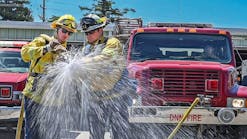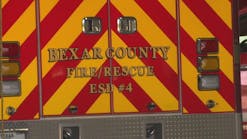They responded to all fire alarms in the downtown districts plus they responded on some second alarms and some third alarms. They could also be special called to any incident. In the first 10 months, Rescue Co. 1 answered 294 alarms. These included fires, gas leaks, ammonia leaks, elevator accidents and one drowning case.
The first officer on Rescue Co. 1 was Lt. Dan Hurley, along with firemen Arthur Gramer, Dan Martell, Crowley, Andrew Larson and John Coleman .He would also be the first Capt. It was not unusual for a Lt. to be the senior officer on some fire companies. Dan Martell was the regular chauffeur and would become a Deputy Fire Chief. Andrew Larson would become a Lt. on Rescue Co. 3.
On August 7, 1920, Rescue Co. 1 received a new Pierce-Arrow rescue van. The department purchased the chassis and the Fire Department shops built the body. They would keep this rig for ten years. This rig was a little bigger and heavier than the first unit. On June 25, 1922 Rescue Co. 1 moved to the quarters of Chemical Co. 2 at 25 Church Street. This building is still standing and being used a private residence.
In the late 1920's there was a need for another Rescue Co. and Rescue Co. 2 was organized on December 10, 1926 at the quarters of Ladder Co. 4, 198 Dudley Street, Roxbury. They used the apparatus of Foamite 1, a 1925 American La France/Childs foamite wagon. With the establishment of Rescue Co. 2 a rescue company would cover a large part of the city.
Rescue Co. 1 moved from Church Street to the new firehouse at 194 Broadway, the quarters of Engine Co. 26-35 on April 17, 1928. They responded to the tenement area of the South End and lumberyards along Albany Street, plus the busy Back Bay area.
Rescue Co. 3 was organized on May 31, 1929 at the quarters of Engine Co. 50, 34 Winthrop Street, and Charlestown. They utilized a 1920 American La France hose wagon. Rescue Co. 3 moved to the new Bowdoin Square firehouse, near the famous Scollay Square, on November 10, 1930. This company would catch plenty of work here including the bustling West End tenement area, the congested North End, the wholesale market area, plus part of downtown.
In January 1930, Rescue Companies 1 and 3 received new enclosed units. They had Federal chassis and bodies built by Perrin-Walsh of Boston. This was a big change over the open units and these rigs had more room for the more equipment the rescue companies were carrying. Some of the newer equipment these rigs carried were: ten Burrill all service gas masks, four Draeger smoke helmets, one inhalator, elevator emergency jack and tools, rubber gloves and Ever Safe high voltage wire tongs. . One of the problems with these rigs was that most of the equipment had to be retrieved from inside the rig.
In December 1931, Rescue Co. 2 received a new open cab American La France type 212 rescue wagon. They would operate with this rig for 16 years. Why the busiest company in the city would use an open rig is unknown. In 1943 Rescue Co. 1 had 1270 runs, Rescue Co. 2 had 1609 and Rescue Co. 3 had 891. This is one of the mysteries of the "job". In 1946, Rescue Co. 2 had 2783 runs, some as far as Readville and Neponset with the open cab rig.
One of the few fires that all three Rescue Companies operated at was the Cocoanut Grove fire on November 28, 1942. Rescue Co. 1 was on the first alarm and Rescue Co 2 and Rescue Co 3 were special called by Deputy Chief McDonough right after he ordered the 4th alarm. Rescue Co. 1 actually transported victims to the Boston City Hospital shortly after they arrived.
On September 21, 1938, Rescue Co. 2 moved from the quarters of Ladder Co. 4 to the quarters of Engine Co. 14 on Centre Street. On January 15, 1946 a two-way radio was installed in the apparatus of Rescue Co. 2. Old veterans of Rescue Co. 2 told me at times on nice days the "all out" was not received on the rig and the company would continue its response.
In 1947, all three rescue companies received Mack rescues with bodies built by Lacey. These were a big improvement over the old Federal rigs. Fireman Edward "Sparky" Leonard of Rescue Co. 2 was detailed to the builder to assist with the placement of compartments and equipment on these new rigs.
In a large city, politics play a part in many things and the fire department is no exception. In 1954, the fire commissioner decided that the city needed only one heavy Rescue Company and he would create five "engine-squad" companies spread around the city.
On September 21, 1954 Rescue Co. 2 was deactivated and the rescue equipment was transferred to Engine-Squad 14. On November 9, 1954 Rescue Co. 1 was deactivated and some of the rescue equipment was transferred to the wagon of Engine Co. 7. They would respond to rescue calls with their wagon only and fire calls with both rigs. At times they were called Squad 7 on the department radio. On January 1, 1955 Rescue Co. 3, in Bowdoin Square, was designated the Rescue Company.
Boston now had one heavy Rescue Company and five engine-squads. The administration felt that this was a better distribution of equipment and manpower. The squads remained in service until the late 1960's.
The Rescue Co. moved from Bowdoin Square to Fort Hill Square, with Engine Co. 25 and Ladder Co. 8 on June 11, 1960. On May 12, 1964 the Rescue Co. received a new Mack/ Gerstenslager rescue van, very similar to Rescue Co. 1 of New York City. In fact members of the Boston Fire Department traveled to New York to inspect and photograph their rig. One of the only differences was the Boston rig had the top painted white and was equipped with an electronic siren, plus a regular "two tone" siren. The first rigs with the white top was the 1947 Macks, this was added after a few years of service and remains a tradition today.
As the Squads were being phased out, a new concept was started with Engine Co. 13, located in Grove Hall. They were assigned a second piece, which was a Civil Defense rescue van. They would operate both units for fire and rescue calls and were know as "The Rescue Pumper Unit" or just "RPU". This became effective on July 12, 1967 and they were equipped with a 1962 Ward La France pumper as well as the 1957 GMC Civil Defense rescue truck. On July 27, 1968 they received a new Ward La France 1250 GPM pumper. During these days the second section ran an old Reo C.D rescue truck. The RPU usually ran with an officer and five firefighters. This concept did give rescue coverage to a large part of the city, as they responded to all working fires, multiples and special calls in Division Two. The RPU lasted until October 25, 1972 when Rescue Co. 2 was re-organized. Rescue Co. 2 was assigned a new rescue van, I t had an International chassis and a body built by Gerstenslager. The Rescue Company downtown was now designated Rescue Co. 1
On August 16, 1973 Rescue Co. 2 moved from 36 Washington Street, Grove Hall to the new fire station at 975 Blue Hill Avenue with Engine Co. 52 and Ladder Co. 29.
Rescue Co. 1 received a new rig on March 1, 1977. This rig had a Ford chassis and a body built by Providence Body Co. The 1964 Mack became a spare.
In June 1978 Boston became infected with the "lime green disease". Engine Co. 10 was painted first and Rescue Co. 1 followed soon after. This color lasted until 1984 when Leo Stapleton became the new Fire Commissioner. Several firefighters had started an effort to have the color changed back to red. The new Commissioner said he thought that might be a good idea so one of the first rigs re-painted was Rescue Co 1's rig. I remember walking into the shop and seeing this and what a great sight to see a rig with fresh RED paint Other rigs followed and in a few years the other color was nearly gone.
Fiscal problems hit the city in the early 1980's and caused the deactivation of over twenty fire companies. Ladder Co. 30 in Egleston Square, Roxbury was deactivated on April 10, 1981 and on the same day, Rescue Co. 2 was moved from Blue Hill Ave. to Egleston Square. This did not last long because on January 14, 1982 Rescue Co. 2 was deactivated again. Rescue Co. 1 would now respond citywide to all working fires, multiples and special calls.
Rescue Co. 1 received a new Ford/Emergency One rescue van with a cascade system on May 1, 1986. The 1977 Ford/Providence became a spare for a short time. One June 3, 1986, for the third time in sixty years, Rescue Co. 2 was reactivated. They were assigned Rescue Co 1's old rig; the Ford/Providence while a new rig was being ordered.
On August 31, 1986, Rescue Co. 2 was responding to a high-rise fire downtown when they were hit broadside by a speeding automobile at the corner of Columbus Ave. and Dudley Street. The driver of the automobile was killed and several firefighters were injured. It was first thought that the rescue rig would be unable to be repaired but after a more careful examination it was decided to repair it. It was back inservice in about one month.
Rescue Co. 2 received a new Ford/Emergency One rescue van on April 11, 1987. This rig was very similar to Rescue Co 1's rig except it did not have a cascade system. For the first time since 1947, both rescue companies had similar rigs.
Rescue Co. 1 received a new Emergency One Protector rescue van with a walk through body on January 3, 1994. This rig has a three-door cab and is air-conditioned.
Rescue Co. 2 received a new similar Emergency One Cyclone rescue van October 30,1996. This rig has a four door cab. Both of these companies respond to all struck boxes in their divisions and multiples and working fires.
The rescue apparatus has come from a small open truck to the modern enclosed vans. The equipment has also progressed from all manual tools to the modern power tools like the "Jaws of Life", the "rabbit tool" and power saws which are carried on all ladder companies. What equipment will the rescue companies carry in 20 years? Who would guess?






